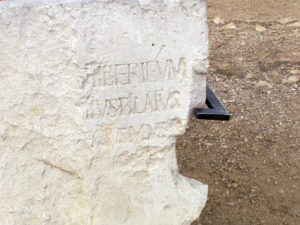
Few historians question the fact that a Jewish Rabbi named Jesus of Nazareth lived and taught around 2,000 years ago. (We do, after all, divide history between the time before and the time after him.) Since the discovery of the Pilate Stone (the image to the right), few question the claim that this Jesus was crucified under Pontius Pilate. The questions around Jesus eventually boil down to his resurrection.
Do we have good reasons to believe that Jesus did, in fact, rise from the dead?
Gary Habermas wrote a helpful book in 2004 called The Case for the Resurrection of Jesus. Here is a summary of his findings from a Washington Post article. The point is that we have sound historical, logical reasons to believe in the truth of Jesus’ resurrection. Of course, we believe on the authority of God’s Word and because we trust in Jesus Himself – for He is the only firm foundation for faith. But research and reasoning demonstrate the strength of the Christian worldview which rests on the historical fact that “He has risen.”
I will assume nothing special about the New Testament writings whatsoever. I will use only the historical information that is accepted as historical by virtually all scholars who have studied this material today-no matter how skeptical or liberal they are. That means, for example, that I will only cite New Testament passages, ones that pass the customary skeptical standards and are recognized as such. Using only these ‘minimal facts,’ I will still maintain that Jesus’ resurrection is the most likely explanation for what we know…
Consider just the following details that the vast majority of skeptical scholars allow:
(1) Most scholars agree that Jesus’ tomb was discovered empty shortly afterwards. With almost two dozen reasons favoring this report alone, what best explains this? Other hypotheses do not account for all the data.
(2) Many eyewitnesses assert that they saw the risen Jesus, both individually and in groups. Even apart from the Gospels, we can establish this totally from just two passages in Paul’s “undisputed writings”…
(3) Further, critical scholars also agree that Paul received this material from the other apostles at an exceptionally early date-only about five years after the crucifixion…
(4) We have first century sources that the three apostles mentioned above were all martyred: Paul, Peter, and James the brother of Jesus… Unlike others, the apostles were in a position to know whether or not they had seen Jesus Christ alive after his death. By being willing to die, scholars agree that they were convinced that Jesus had indeed appeared to them…
5) Of these eyewitnesses, Paul was a persecutor of the early Christians, and James was an unbeliever. Skeptical scholars accept this in both cases. But why did they become believers? Again, they were certainly in a position to know whether the risen Jesus had appeared to them…
Altogether, these five reasons are each based on a well-evidenced foundation, built on texts that are accepted as historical by virtually all scholars, whatever their religious persuasion. Readers who choose to reject them must consider whether they are doing so for other than factual reasons.
See more of Dr. Habermas’ excellent research and writing here: garyhabermas.com
